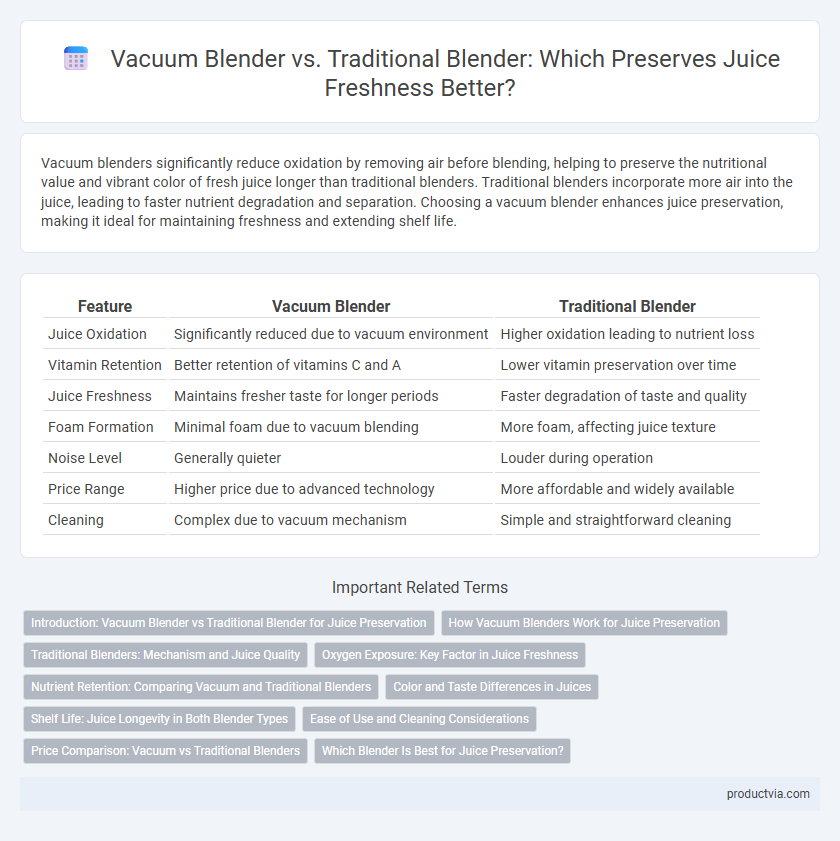Vacuum blenders significantly reduce oxidation by removing air before blending, helping to preserve the nutritional value and vibrant color of fresh juice longer than traditional blenders. Traditional blenders incorporate more air into the juice, leading to faster nutrient degradation and separation. Choosing a vacuum blender enhances juice preservation, making it ideal for maintaining freshness and extending shelf life.
Table of Comparison
| Feature | Vacuum Blender | Traditional Blender |
|---|---|---|
| Juice Oxidation | Significantly reduced due to vacuum environment | Higher oxidation leading to nutrient loss |
| Vitamin Retention | Better retention of vitamins C and A | Lower vitamin preservation over time |
| Juice Freshness | Maintains fresher taste for longer periods | Faster degradation of taste and quality |
| Foam Formation | Minimal foam due to vacuum blending | More foam, affecting juice texture |
| Noise Level | Generally quieter | Louder during operation |
| Price Range | Higher price due to advanced technology | More affordable and widely available |
| Cleaning | Complex due to vacuum mechanism | Simple and straightforward cleaning |
Introduction: Vacuum Blender vs Traditional Blender for Juice Preservation
Vacuum blenders reduce oxidation by removing air before blending, significantly preserving the vitamins and nutrients in juice compared to traditional blenders. Traditional blenders introduce more oxygen during blending, which accelerates nutrient degradation and reduces juice freshness. Vacuum blending extends juice shelf life while maintaining vibrant color and natural flavor.
How Vacuum Blenders Work for Juice Preservation
Vacuum blenders preserve juice by removing air from the blending container before blending, significantly reducing oxidation and maintaining the juice's nutrients, color, and flavor longer than traditional blenders. This oxygen-free environment slows down enzymatic browning and nutrient degradation, ensuring fresher-tasting juice over extended periods. Unlike traditional blenders that introduce air through high-speed blending, vacuum blenders create a sealed, low-oxygen space that optimizes juice quality and shelf life.
Traditional Blenders: Mechanism and Juice Quality
Traditional blenders operate with high-speed blades that create turbulence and heat, which can accelerate oxidation and degrade the nutrients and flavor in juice. The intense blending action introduces air into the mixture, causing faster nutrient loss and reduced shelf life compared to vacuum blenders. As a result, juice produced by traditional blenders often exhibits lower antioxidant levels and diminished freshness during storage.
Oxygen Exposure: Key Factor in Juice Freshness
Vacuum blenders minimize oxygen exposure during blending by creating a low-pressure environment, which significantly reduces oxidation and preserves the nutritional quality and vibrant color of fresh juice. Traditional blenders introduce more air, leading to faster degradation of antioxidants, vitamins, and flavor compounds in the juice. Using a vacuum blender extends shelf life and maintains freshness by slowing down enzymatic reactions caused by oxygen contact.
Nutrient Retention: Comparing Vacuum and Traditional Blenders
Vacuum blenders operate by removing air before blending, significantly reducing oxidation and nutrient degradation in juice compared to traditional blenders that expose ingredients to oxygen during blending. Studies show vacuum blending preserves higher levels of vitamin C, antioxidants, and enzymes, enhancing the overall nutritional quality of fresh juices. This nutrient retention makes vacuum blenders ideal for users seeking maximum health benefits and longer-lasting juice freshness.
Color and Taste Differences in Juices
Vacuum blenders reduce oxidation by removing air before blending, preserving the vibrant color and fresh taste of juices compared to traditional blenders. This process minimizes nutrient loss and prevents browning, keeping juices visually appealing and flavorful for longer. Studies show vacuum blending retains higher levels of antioxidants, enhancing the overall juice quality.
Shelf Life: Juice Longevity in Both Blender Types
Vacuum blenders remove air before blending, significantly reducing oxidation and preserving juice freshness for up to 72 hours, compared to traditional blenders that expose juice to oxygen, limiting shelf life to 24 hours. The vacuum extraction process minimizes nutrient degradation and enzymatic activity, enhancing juice longevity and maintaining vibrant flavor and color. Traditional blenders often result in quicker nutrient loss and separation, requiring immediate consumption for optimal quality.
Ease of Use and Cleaning Considerations
Vacuum blenders feature sealed containers that minimize oxidation, enhancing juice preservation without adding complexity to operation. Traditional blenders have simpler designs but often require more time for cleaning due to open jars that trap pulp and residue. Both types typically offer detachable blades, but vacuum blenders may demand additional steps to maintain airtight seals, influencing ease of cleaning.
Price Comparison: Vacuum vs Traditional Blenders
Vacuum blenders typically carry a higher price tag than traditional blenders due to advanced technology that removes air before blending, which helps preserve nutrients and flavor in juice. While traditional blenders are more affordable and widely available, they often allow oxidation that can reduce juice freshness and shelf life. Investing in a vacuum blender may offer long-term value by maintaining juice quality, despite the initial higher cost.
Which Blender Is Best for Juice Preservation?
Vacuum blenders, such as the Blendtec Vacuum Jar, significantly reduce oxidation by removing air before blending, preserving nutrients and color better than traditional blenders. Traditional blenders expose juice to more oxygen during blending, leading to faster nutrient degradation and browning. For optimal juice preservation, a vacuum blender maintains freshness and extends shelf life by minimizing oxidation.
Vacuum blender vs traditional blender for juice preservation Infographic

 productvia.com
productvia.com